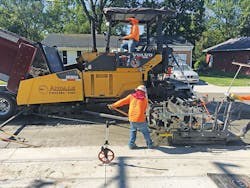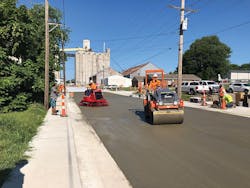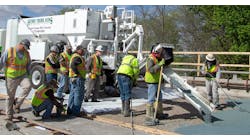By: Todd Kempker, P.E.
In 2019, the city of Mexico, Missouri, needed a fast, affordable, and durable solution when reconstructing the only access route for one of the area’s largest industrial employers.
The deterioration of Holt Street was largely driven by years of heavy truck traffic progressing through the quarter-mile residential section to access an Archer Daniels Midland (ADM) soybean processing facility. That same facility meant traffic management was imperative during the reconstruction of Holt Street.
In order to keep traffic moving, construction crews staged alternate routes through side roads to facilitate continuous access, all while coordinating closely with the ADM facility and nearby residences. Altogether, about 100 cars and 100 heavy trucks were redirected daily to ensure safety during the life of the project.
“This soybean processing facility is responsible for millions of dollars per year for Archer Daniels Midland and is critical to the city of Mexico’s economy,” said city of Mexico Engineer Kensey Russell, P.E. “We needed to serve the needs of the facility by reconstructing the road, but we also needed to include a traffic management plan that facilitated continuous operations throughout the life of the project. Traffic management was important for ADM, but also for the safety of nearby residents in terms of emergency service access.”
Innovative Pavement Solution
Even with continuous traffic management, it was critical that the quarter-mile reconstruction project conclude as soon as possible so the industrial-residential corridor could resume normal operations. Thus, the city of Mexico needed a highly efficient paving option that would withstand the test of time and the demands of industrial truck traffic. To meet this goal, the city and design consultant Bartlett & West investigated the use of compacted concrete paving (CCP) as a viable solution.
As a relatively new technology in the paving industry—never used previously within the state of Missouri—CCP combines the durability of concrete paving with the installation speed of asphalt paving. CCP is considered an improvement upon the more widely-known Roller Compacted Concrete (RCC) because it is able to be finished like conventional concrete pavement. Installation of the project was awarded to Andale Construction of Wichita, Kansas, a leader in the construction of CCP projects.
Asphalt is generally believed to be more cost-effective, quicker to place, and open to traffic sooner. Conversely, concrete pavement is often expected to have a longer life span while being more costly to place and requiring more time to open to traffic. CCP provided the benefits of both products.
RCC had been used in some locations in Missouri in recent years, as an effort to place concrete in a manner similar to asphalt while having the life span of conventional concrete. However, RCC does not provide the appearance and smoothness of conventional pavement options. By contrast, the multistep finishing process involved with CCP generally delivers a smoother, higher-quality end result.
Refining the Finishing Process
CCP is a no-slump concrete that is compacted to 98% laboratory density. It is a well-graded mix with several additives allowing high-density modified asphalt pavers to place and compact the concrete. This paver that achieves the vast majority of the required compaction is one of the key differences between CCP and the more standard RCC. It reduces the need for the roller and the variability that is introduced with rolling the concrete. Typical densities realized from the paver reach 95% or higher. The pavement is then compacted with a finishing roller to achieve ultimate compaction of 98%. Ultimately, the city of Mexico selected CCP as the perfect solution for optimizing construction time and long-term durability.
CCP contains admixtures that reduce the water content in the concrete and also suspend water in the mix until it is mechanically activated by the paver. A patented finishing agent is also used to help provide better workability on the concrete surface without impacting the integrity of the pavement. When combined with a power trowel and broom technique, it allows for an even better finish. In the end, CCP appears just like conventional concrete pavement, whereas RCC has a rough surface that does not appear like concrete.
The Design Process
Because CCP innovation is mainly a construction method, the design process saw very little change. The project’s overall scope involved full-depth reconstruction of the two-lane roadway, with rollover curbs to match existing curbs and minimize driveway replacements. Pavement thickness of 8 in. was chosen as the ideal depth for durability, density, and constructability.
Sidewalk on each side of the roadway was also replaced with a wider, ADA-compliant sidewalk. This was designed around utility poles located directly on the back of curb in order to stay within existing right-of-way constraints as much as possible. Permitting, stakeholder engagement, and utility coordination proceeded as usual on the project, with close collaboration and frequent communication to expedite processes as much as possible.
During construction, subgrade soil conditions were discovered to be in poor condition, with a CBR of one and extremely saturated by periodic heavy rains during construction. Design and construction teams considered responding to the challenge with a deep undercut and aggregate stabilization, but that was considered cost-prohibitive and impractical considering the presence of subsurface utilities. The teams moved forward with a 10-in. cement stabilization, which proved the most feasible and efficient option for improving the subgrade.
Innovative Funding
While time was of the essence, so was funding. The city identified the Accelerated Innovation Deployment (AID) Demonstration program as a possible source of funding. Bartlett & West followed up with preparing and coordinating an application through the Missouri Highway and Transportation Department. The AID program, led by the Federal Highway Administration, provides funding as an incentive to accelerate the implementation and adoption of innovation in highway transportation.
Fortunately, the innovative nature of CCP made the Holt Street project a strong candidate for AID funding. The application was successful for this FHWA grant, administered by the Missouri Department of Transportation. In fact, the AID grant covered 80% of the $836,000 reconstruction project.
“To meet the grant criteria, we used compacted concrete paving, hosted a meeting on the day of paving for industry partners to observe and learn, and we also prepared a final report for FHWA to recap lessons learned from this innovative project,” said Steve Schultz, P.E., the Bartlett & West engineer who helped the city secure the grant.
The CCP Difference
The use of CCP allowed for all paving operations to occur in a single day. Furthermore, cure time was minimized due to the innovative material meeting a required compressive strength sooner than traditional materials would have. In fact, field data showed that Holt Street could have reopened within 24 hours of construction. However, because an adequate traffic management plan was in place, alleviating some of the schedule pressures, the project team chose a more conservative approach with a seven-day cure time. This allowed the pavement to achieve 4,600 psi before reopening.
The relatively dry mix allowed the project to achieve a rapid early strength, thereby limiting the downtime of grain trucks accessing the ADM facility. Unique characteristics that made CCP more desirable than traditional concrete pavement included no reinforcement, no formwork, and the laying method resembling that of asphalt.
“Data shows we saved at least a half-day of production time by using compacted concrete paving, and preserved emergency access for our residents.” Russell said. “There is no doubt the CCP method made a difference on this short—but very important—corridor for the city of Mexico.”
About The Author: Kempker is senior project manager with Bartlett & West.




